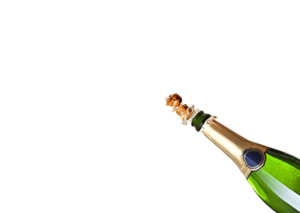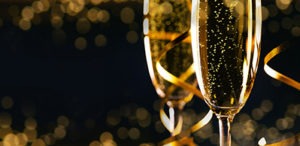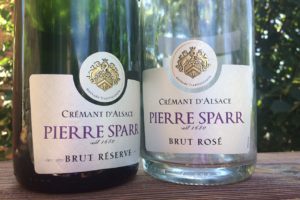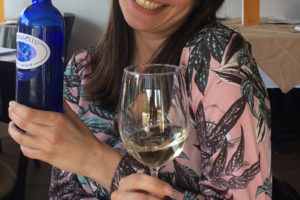You may have heard a lot about a Champagne shortage, but that doesn’t mean there’s a shortage of bubbly. Just of high-end Champagne. You can’t stumble through an LCBO outlet without hitting a sparkling wine display, and Ontario wineries have a plentiful supply. So don’t sweat it if you’re about to head out to grab a last-minute bottle to pop tomorrow night.
 But first, a rapid Bubbly 101 for you: You can only officially call it Champagne if it’s from the Champagne region of France. Even if you make it using the same traditional method they use there (where the second fermentation takes place in the bottle instead of a hulking tank), you still have to call it something else, like Crémant d’Alsace (as they do in northeastern France), Cava (Spain), Sekt (Germany), or simply “Traditional Method” in Ontario.
But first, a rapid Bubbly 101 for you: You can only officially call it Champagne if it’s from the Champagne region of France. Even if you make it using the same traditional method they use there (where the second fermentation takes place in the bottle instead of a hulking tank), you still have to call it something else, like Crémant d’Alsace (as they do in northeastern France), Cava (Spain), Sekt (Germany), or simply “Traditional Method” in Ontario.
Next, a here’s a quick primer on how to open the bottle. Keep in mind that there’s about 30-60 PSI in a bottle of Prosecco and 90+ PSI in a bottle of Champagne (almost three times that of the average car tire). This kind of bottled-up energy can launch a champagne cork at about 80 km/hr—fast enough to shatter glass, much less cause permanent eye damage. So you really should take this seriously.
1. Remove the foil.
2. Tilt the bottle at a 45 degree angle away.
3. Put your thumb atop the cage and keep it there.
4. Unwind the cage tie (usually about six twists) DO NOT REMOVE THE CAGE
5. While keeping your thumb atop the loosened cage, twist the bottle with your lower hand.
6. As the pressure begins to push the cork out, maintain enough grip atop the cork so that you slowly “accept” it into your top hand, allowing a muffled popping sound. (Now, if you’re really looking for that ceremonial pop, you can let it explode out of the bottle more rapidly, but still keep a grid atop the cork so you control its exit and it doesn’t end up flying into someone’s face.)
I’m not going to dive into which type of sparkling you should choose. Suffice it to say that if you’re looking for something complex with very fine bubbles with citrus, almond and brioche notes, go for Champagne or another ‘traditional method’ sparkling. If you’re just in it for something refreshing to party with—especially if money is a factor—go for Prosecco or another ‘tank method’ sparkling, which are generally less than half the price since they’re so much easier (and faster) to produce.
 That Bubbly Buzz
That Bubbly Buzz
If you feel like bubbly hits you a little harder than a regular glass of wine, it’s because it actually does. The Germans even have a word for it: “Sektlaune,” meaning “Champagne flush. A sparkling mood, adventurous mood, tending to become involved in risky activities.” It’s probably meant as a warning in Deutschland: “Beware the inhibition-removing powers of bubbly!”
For even though the typical alcohol level in a bottle of sparkling wine (11-12%) is lower than still wine, those carbon dioxide bubbles are like little ninjas attacking your sobriety. As Business Insider notes, this is because the CO2 “in sparkling drinks increases the permeability of your biomembranes, letting more alcohol into your bloodstream.” In other words, alcohol is absorbed quicker, hence the quick buzz that most of us experience.
Another issue with bubbly is that, as a welcoming, celebratory aperitif, it tends to be imbibed on an empty stomach, and often consumed more quickly than, say, your casual glass of pinot grigio or cabernet sauvignon. Which makes it doubly dangerous.
And it’s exponentially more popular this time of year! While all sparkling wine producers have been trying to remind North Americans that bubbly is not just for special occasions, the LCBO still sees a whopping 1/3rd of all sparkling wine sales from mid-November to December 31. (The LCBO will register over $40 million in sales of all products on New Year’s Eve alone!)
As far as the glass itself goes, if it’s a cheap bubbly, a Champagne flute will do just fine, as the moment is probably more about the celebration than the quality of a particular vintage. But if someone has taken the time and expense to purchase a decent bottle, reach for a thin-topped white wine glass. It’ll give you the chance to actually enjoy the nuances of the wine’s aromas—it is wine, after all—as opposed to your nostrils merely being consumed by the rising bubbles from a flute.

Regardless of the type of vessel you select, make sure your glasses are ‘sparkling’ clean, as bubbles are unable to cling to even a modicum of lint or soapy lining. So to ensure the most dramatic bubble trail, it’s best to wipe your glasses with a clean towel before you pour.
And if there’s anything left over, you’ve got about three to four days that it will keep if a proper sparkling wine stopper is clamped atop the bottle.
So a toast to a safe and Happy New Year! And the end of Covid restrictions in 2022!
And when someone tells you that Champagne goes straight to their head, you can now explain why.




Leave a Reply
Your email is safe with us.